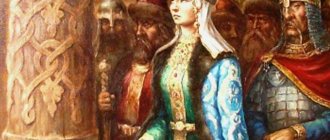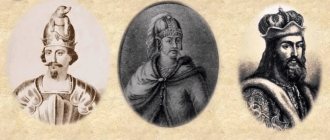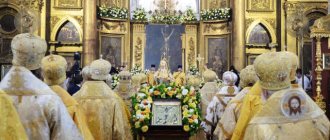Then she was made a saint.
Princess Olga was included in the first version of the World Economic Forum ranking. She was praised, noted for her great role in history, and was even called the progenitor of Russia. This fact outraged Petro Poroshenko - he said that Olga was a Kyiv princess, and Moscow was founded only 3 centuries later. There were other errors in the description: for example, the princess's husband was called Ivan, although he was Igor. Poroshenko asked to correct the mistakes, but in response Olga was removed from the list.
We tell you what Princess Olga remembers.
According to one legend, Olga was married off at the age of 10.
It is believed that she was of humble birth and met Igor by chance. One day the prince had to swim across the river, and he got into a boat with a stranger. When they had already set sail, Igor saw that there was an incredibly beautiful girl in the same boat with him. He tried to seduce her, but Olga gave a decisive refusal. Igor was impressed by her chastity, so he decided to marry her.
Photo: Fomma
Chronicle data
The story of Princess Olga is so complicated that historians still put forward hypotheses regarding her life and origins. Olga loudly declared herself in the international arena, popularized the Christian religion in order to get rid of the humiliating label of “barbarians” among European countries, and centralized the power of Kievan Rus. And yet she left behind many mysteries.
Various pieces of information contradict each other, and the numbers don’t add up. This suggests that history is full of not only facts, but also fiction, and it is sometimes difficult to distinguish one from the other. Nobody knows the date of birth of Princess Olga to this day. The “Steppe Book” states that she passed on to another world at the age of 80. The “Arkhangelsk Chronicler” says that Olga got married at the age of 10. Scientists compared the data and calculated that the princess should have been born in 893.
Her son Svyatoslav, in accordance with the Ipatiev list of the Tale of Bygone Years, was born in 942, others call the period from 938 to 943. This means that Olga gave birth to her eldest son at the age of 45-50. Her wedding date also remains in doubt.
Olga took revenge on the Drevlyans who killed her husband
Igor decided to collect tribute from his subjects twice. The Drevlyans did not tolerate this and killed the prince. After his death, Olga took the throne, since their son was still small. She ordered the Drevlyans to be buried alive, their ambassadors to be killed, and people to be slaughtered during prayer. The most famous revenge was a fire: Olga ordered tinder to be tied to the birds’ legs, set them on fire and released into the wild. As a result, the city was burned, and the people were again subjected to tribute.
Photo: Cyrillic
Revenge of the young princess
At first glance, the princess favorably accepted the offer and even promised unprecedented honors to the ambassadors.
The next day they were to be brought to her mansion directly in the boat. And indeed, the satisfied ambassadors were brought to Olga in a boat, and together with the boat they were thrown into a pre-prepared hole and buried alive. However, this was not enough for Olga. She sent her ambassador to the unsuspecting Drevlyans demanding that a more magnificent and numerous embassy be sent for her. The ambassadors who arrived soon were given a very warm welcome, offering to take a steam bath on the way. There they were locked and burned alive.
After this, Olga informed the Drevlyans, who were unaware of the fate of their ambassadors, that before her second marriage she wanted to perform a funeral feast over the grave of her first husband. The funeral feast, which took place near the city of Iskorosten, where Igor was killed, involved 5 thousand noble Drevlyans, who were then hacked to pieces by the princess’s soldiers.
Olga converted to Christianity
Many people mistakenly think that Vladimir was the first Christian on the throne, but his grandmother Olga accepted the Orthodox faith. She took this step to strengthen ties between Russia and Byzantium. Constantine VII even wanted to marry her, but Olga remained faithful to Igor. She managed to avoid marriage by cunning: she asked Konstantin to be her godfather, which is why they were later unable to get married.
Photo: Postel-Deluxe.ru
Assumptions of Mikhail Grushevsky
Mikhail Grushevsky in his monograph “History of Ukraine-Rus” writes that Olga could have ruled Russia even before Igor. The historian suggests that between the regency of Oleg and Igor, the throne was occupied by another prince, about whom there is no data in history. Perhaps it was Olga, if she really was the daughter of the Prophetic Oleg.
Ekaterina Skulkina shared how she hides from excessive public attention
Anti-aging midi haircuts for spring 2021: tips for choosing a trendy model
Helping parents around the house: the dangers of overindulging children
In folk art, it was she, and not Igor, who was glorified as the honorary heir to the throne. In accordance with this legend, Olga becomes Igor’s wife, as the law required this, and shares power with him. This order of events indicates that the wedding took place not in 903, but in the late 30s, which explains the late date of Svyatoslav’s birth.
Princess Olga's secret weapon is the famous "Greek Fire"?
...Tying a piece of tinder to the birds, he set it on fire and released the birds into the city. They flew to their nests and burned the city of the Drevlyans. Iskorosten has fallen. Olga imposed an exorbitant tribute on the surviving townspeople. For many years, the legend about the miraculous capture of the Drevlyan fortress was passed down from generation to generation. The chronicler willingly included it in “The Tale of Revenge.” Historians pass over this episode in silence. This is not surprising - the chronicle version raises a number of questions.
In the first half of 946, the Kiev princess Olga set out on a campaign against the Drevlyans, who had killed her husband, Prince Igor, a year earlier. The troops took several Drevlyan fortresses. But Iskorosten (Korosten), the city of Prince Mal on the Uzh River, could not be conquered straight away. The protracted siege decayed the morale of the squad. The princess was also worried about the approaching autumn thaw. This prompted her to search for an extraordinary solution...
Military stratagem
A wise and great woman began peace negotiations. Surprised by her gentleness, the Drevlyans asked: “What do you want from us? We are happy to give you honey and furs." But she answered: “Now you have neither honey nor furs, so I ask you for a little: give me three pigeons and three sparrows from each household.” Having distributed to her soldiers, some a dove, some a sparrow, she ordered to tie a small piece of tinder to each bird. And when it began to get dark, she ordered the tinder to be set on fire and the birds to be released into the wild. They flew to their nests, and then dovecotes, cages, barns and haylofts burst into flames. And there wasn’t a yard where it wasn’t burning...
Iskorosten has fallen. Olga imposed an exorbitant tribute on the surviving townspeople. For many years, the legend about the miraculous capture of the Drevlyan fortress was passed down from generation to generation. The chronicler willingly included it in “The Tale of Revenge.” Historians pass over this episode in silence. This is not surprising - the chronicle version raises a number of questions.
Why did Olga wait for the approach of autumn and not use the “bird version” much earlier? Why were the pigeons and sparrows released after dark? Why, finally, should a bird carrying fire fly headlong to its native nest?
What was hidden behind the mysterious burning birds? What if Princess Olga used some mysterious weapon that had incredible power at that time? Is it possible?
Brahma Weapon
...A hot battle unfolded near the walls of the ancient city. The ringing of weapons and armor, the dying groans of people and the neighing of defeated horses merged into one terrible cacophony. And in the middle of this raging sea of death, like moving cliffs, huge war elephants towered, crushing the doomed screaming in fear.
The scales were shaking. The defenders' troops wavered. The enemy pressed them towards the open gates of the city. There was only one last resort left. The ruler, once again looking around the battlefield, raised his hand, giving a sign to the priests. “Weapon of Brahma! Weapon of Brahma! - A reverent whisper swept among those close to him.
Several people dressed in black robes carried out of the temple a long, pointed object - a huge iron arrow. It was carefully placed on a special stone pedestal with a long polished groove.
The priests knelt down and, loudly shouting sacred words, called on the god Brahma to accurately aim their weapons at the enemies.
The senior priest was given a torch mounted on a long bamboo pole. He waited until everyone had left the site, and, taking cover behind a stone ledge, he brought the torch to the iron arrow.
Like a thousand snakes, she hissed, like a thousand thousand hearths, she exhaled smoke and, with a roar like thunder, took off from her place. Within a moment the chariots were on fire. People, horses, elephants lay defeated, burned by a terrible explosion...
What is this? Another science fiction story about war on another planet? No, the events described took place here on Earth, apparently, almost three thousand years ago.
Historical monuments and chronicles of the past contain mention of unusual weapons. Here is its description from the ancient Indian work “Mahabharata”. “A blazing projectile with the radiance of fire was released. A thick fog suddenly covered the army. All sides of the horizon were plunged into darkness. Evil whirlwinds arose. The clouds roared into the heights of the sky... It seemed that even the sun was spinning. The world, scorched by the heat of this weapon, was in a fever...” An impressive ancient story! And far from the only one.
According to the recipes of the ancient Greeks
...In 717, Theophanes in his “Chronography” talked about the capture of the Sideron fortress, located in the mountain pass between Tsebelda and Sukhumi. Spafari Lev besieged the fortress, but the location and strength of the fortifications did not allow it to be captured. Leo made an agreement with the defenders of the fortress, promising not to harm them, if only they would let him and 30 soldiers in. “But,” wrote Theophanes, “Leo did not keep his words, but ordered his thirty companions: “When we enter, seize the gate and let everyone enter.” As soon as this happened, the spafarius ordered fire to be thrown in the direction of the fortress. A big fire started, and families began to leave, taking with them what they could carry of their property.
One of the eyewitnesses wrote that the incendiary mixture was thrown towards the enemy from special copper pipes. This sight caused horror and surprise to the enemy. The flammable mixture was applied to a metal spear launched by a giant sling. It flew with the speed of lightning and with a thunderous roar and looked like a dragon with the head of a pig. When the projectile reached the target, an explosion occurred, a cloud of acrid black smoke rose, after which a flame arose, spreading in all directions; if they tried to extinguish the flame with water, it flared up with renewed vigor...
Most researchers date the appearance of Greek fire to the 7th century and associate it with a certain Kallinnikos from Heliopolis in Syria. For example, a certain Byzantine historian reports: “In the year 673, the overthrowers of Christ undertook a great campaign. They sailed and wintered in Cilicia. When Constantine IV learned of the approach of the Arabs, he prepared huge double-decker ships, equipped with Greek fire, and ships that carried siphons... The Arabs were shocked, they fled in great fear.” The Byzantines carefully kept the secret of Greek fire, but in the 10th century in Rus' they already knew about it...
Secret deal
In 941, Prince Igor of Kiev went on a campaign against the Greeks. The Byzantine Emperor Roman sent his troops led by Theophan Patricius towards the Rus. There was a collision. “...And of course,” the chronicler wrote, “the Russians would have won, but the Greeks began firing pipes at the Russian boats. And the quick vision is scary. Rus', seeing the flames on themselves, rushed into the sea water, wanting to escape. Then many Russian people and Greek boats were burned and drowned...” The news of this defeat soon reached Rus'. “When they came, they told about the former misfortune from the fire, and the Greeks, having it on their ships, set sail and burned the ships.”
Finding herself in a hopeless situation under the walls of the Drevlyan Iskorosten, Olga turned to Byzantium for help. That's why we had to wait so long. The ambassadors of the Kyiv princess secretly arrived in Constantinople, concluded an agreement and received weapons. The agreement was not recorded anywhere, because it violated the law “prohibiting the sale of weapons to barbarians.”
...Deceit, deceit, and unsurpassed cruelty of the ruler did not go beyond the morality of that time. They are not condemned by the chroniclers, but on the contrary, they are glorified as the properties and advantages of the highest wisdom. As for the reasons for her cruel actions, they were caused not so much by a feeling of revenge, but by a desire to establish herself as the head of the principality, to prove to everyone that she, Olga, could rule with a hand no less firm than that of male rulers.
Alexander FOMIN,
https://www.vvnews.info
“The Book on Fire for Burning Enemies” by Mark the Greek became the first textbook for training rocket scientists. It indicated in detail how to prepare an incendiary mixture and what to do with it then: “... take 1 part rosin, 1 part sulfur, 6 parts saltpeter, dissolve finely in linseed or laurel oil, then put it in a copper pipe or in a wooden trunk. The rocket must be long, and the gunpowder in it must be packed tightly. Both ends should be tightly tied with iron wire. The ignited charge immediately flies in any direction and destroys everything with fire.”









